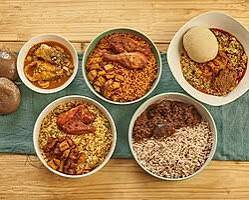Types of Food in Africa
Africa is a continent known for its cultural and environmental diversity, and this richness is reflected in its food. Each region has its own traditions, ingredients, and cooking techniques shaped by climate, history, and available resources. Although African cuisines differ widely from country to country, they share common themes such as the use of fresh vegetables, grains, spices, and locally sourced ingredients. Below is an overview of the major types of food found across Africa, organized by region and culinary style.
1. West African Foods
West Africa is famous for its boldly flavored dishes, rich stews, and use of spices such as ginger, garlic, chili, and pepper. Food in this region typically includes grains, root vegetables, and proteins like fish or goat.
Staple Foods:
- Jollof Rice – A widely popular dish cooked with rice, tomatoes, onions, and spices. Each country has its own version, with Nigeria, Ghana, and Senegal famously debating whose is best.
- Fufu – A smooth, stretchy dough made from cassava, plantain, or yam, usually eaten with soups and stews.
- Banku and Kenkey (Ghana) – Fermented corn and cassava dough often served with fish.
- Waakye – A Ghanaian rice-and-beans dish cooked with millet leaves, giving it a brownish color.
Popular Soups and Stews:
- Egusi Soup – Made from melon seeds, vegetables, and sometimes meat or fish.
- Groundnut (Peanut) Soup – A creamy, protein-rich soup enjoyed in Ghana and Nigeria.
- Okra Soup – Common in Nigeria, Sierra Leone, and Liberia.
2. East African Foods
East African cuisine is influenced by Arab, Indian, and coastal cultures. The region is known for lighter dishes, flatbreads, stews, and grilled meats.
Common Foods:
- Ugali (Kenya, Tanzania, Uganda) – A stiff maize porridge similar to fufu, eaten with vegetables, beans, or meat.
- Injera (Ethiopia, Eritrea) – A soft, spongy sourdough flatbread made from teff flour, used as both a plate and utensil.
- Wot (Ethiopian Stew) – Thick stews made with lentils, chicken, or beef, seasoned with berbere spice.
- Pilau and Biryani – Rice dishes brought by Indian and Arab traders to the Swahili coast.
Meat and Side Dishes:
- Nyama Choma – Grilled goat or beef, popular in Kenya and Tanzania.
- Chapati – A flatbread introduced from South Asia.
3. North African Foods
North African cuisine is very distinct from the rest of Africa due to historical influences from the Middle East, Mediterranean, and Arab world. It features couscous, fragrant spices, dried fruits, and slow-cooked dishes.
Key Foods:
- Couscous (Morocco, Algeria, Tunisia) – Steamed semolina grains served with vegetables and meat.
- Tagine – Slow-cooked stew prepared in a clay pot, often made with chicken, lamb, apricots, or olives.
- Ful Medames (Egypt) – A dish made with cooked fava beans, olive oil, and spices.
- Hummus and Falafel – Common in Egypt and Sudan due to Middle Eastern influence.
Flavor Profiles:
- Heavy use of cumin, coriander, cinnamon, paprika, saffron, and mint.
- A balance of sweet and savory flavors.
4. Central African Foods
Central Africa uses simple cooking techniques and emphasizes natural, earthy ingredients. Cassava, plantains, peanuts, and fish are central to the cuisine.
Major Foods:
- Fufu and Plantains – Widely eaten with stews.
- Saka-Saka (Congo) – Cassava leaves cooked with ground peanuts and fish.
- Moambe Chicken (DRC, Congo) – Chicken cooked in a thick palm nut sauce.
- Grilled Fish – A popular street food near rivers and lakes.
This region relies heavily on cassava, both the root and the leaves, making it one of the most important staples.
5. Southern African Foods
Southern Africa has a blend of indigenous foods and European influences. The cuisine is hearty and often involves grilled meats, maize-based dishes, and vegetables.
Typical Foods:
- Pap (South Africa, Botswana) – A type of maize porridge similar to ugali.
- Biltong – Dried, cured meat, somewhat similar to jerky.
- Bunny Chow (South Africa) – Hollowed-out bread filled with curry, influenced by Indian immigrants.
- Sadza (Zimbabwe) – Maize meal eaten with meat or vegetables.
- Chakalaka – A spicy vegetable relish.
Conclusion
African food is incredibly diverse, shaped by geography, history, and culture. From the spicy stews of West Africa to the aromatic dishes of North Africa and the grilled meats of Southern Africa, the continent’s cuisine reflects its rich heritage. What ties African food together is the emphasis on community, fresh ingredients, and bold flavors. Whether enjoyed in rural villages or modern cities, African dishes continue to celebrate tradition while evolving with new influences.


